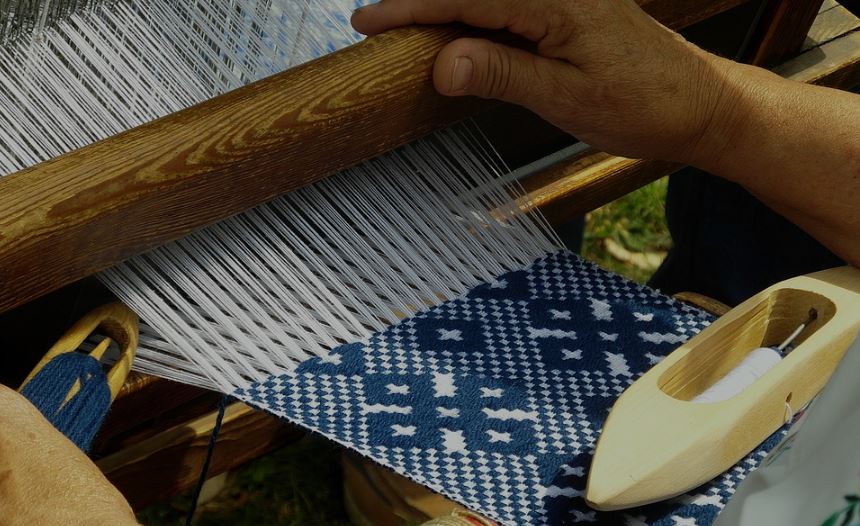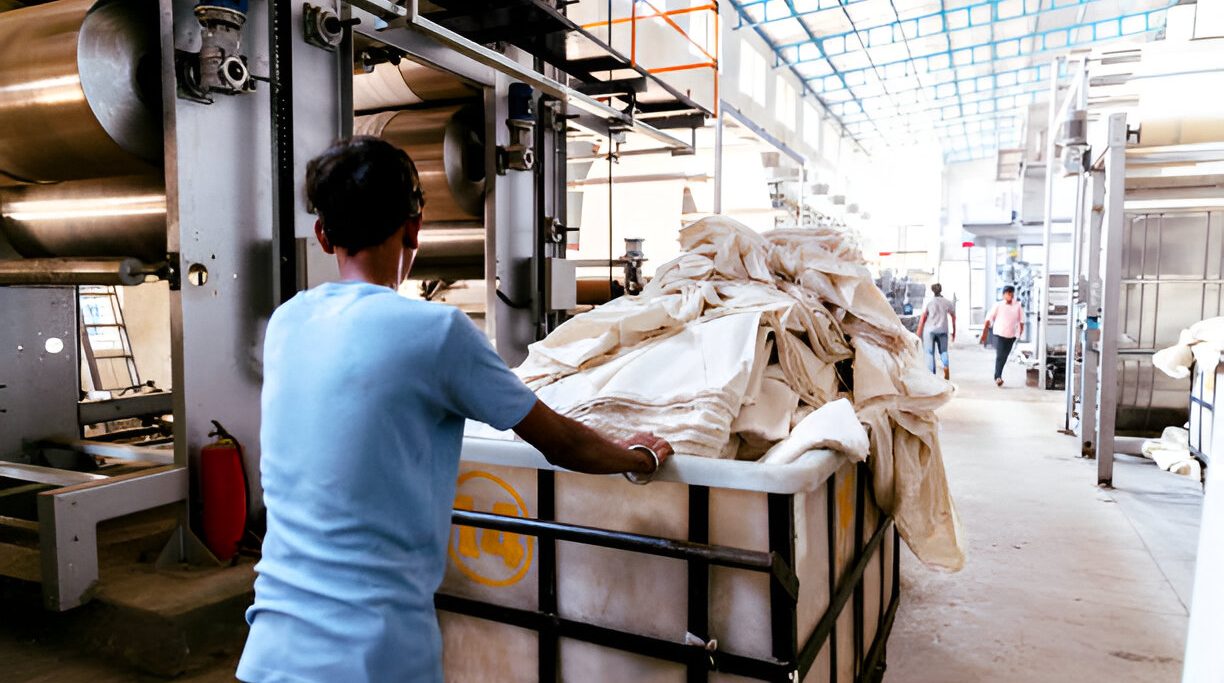The process of using reels of yarns and threads to create a solid fabric can be intriguing, and is both a science and an art.
With the evolution of technology, there has been significant changes in the ways textiles are manufactured. Yet the oldest and most significant methods for making materials are textile weaving and knitting. Both of these processes entail weaving together yarn or thread to create a fabric, but they do so in different ways.
Weaving : In weaving, two sets of yarn or thread are interlaced at right angles to one another to create a fabric. The crosswise threads are referred to as the weft or filling, and the lengthwise threads are known as the warp. On a loom, the weft is woven through the warp while the warp is kept taut by a shuttle or other instrument. The end product is a fabric with an even grid-like pattern of threads that are interlaced. Weaving comes in a variety of forms, such as plain weave, twill weave, and satin weave. The weft alternates over and under the warp to create a plain, tight weave in plain weave. Satin weave creates a smooth, shiny surface, while twill weave results in a diagonal pattern in the cloth. From hardy denim to delicate satin, every type of weave has its own distinct qualities and uses.
A variety of tools and technologies have been created over time to help in the weaving process, increasing its efficiency and reducing its labour-intensiveness.
HANDLOOM:
The ancient weaving technique known as the handloom has been in use for many years. It entails weaving fabrics on a manually operated loom. Using pedals, levers, and a shuttle, the weaver directs the movement of the warp and weft threads. A single piece of fabric might take several hours or even days to weave on a handloom, which calls for great skill and patience, thus making handloom produced fabrics more expensive .
POWERLOOM:
A power loom is a textile-weaving device that employs automated technologies. The textile business underwent a revolution when it was created in the 18th century. The power loom can weave fabrics considerably more quickly and effectively than a handloom since it is powered by steam or electricity. To interlace the weft threads, the machine has a shuttle that swings back and forth over the warp threads.
WATERJET LOOM:
A particular kind of power loom called a water jet loom uses water to drive the weft threads across the warp strands. The weft threads are carried across the cloth by the machine’s water jet nozzle, which sprays water at a high pressure. Water jet looms can create high-quality fabrics with little waste and are faster than traditional power looms.
AIRJET LOOM:
Another kind of power loom that employs compressed air to move the weft threads over the warp threads is the air jet loom. The device contains a pneumatic nozzle that propels compressed air across the fabric to move the weft threads. Compared to water jet looms, air jet looms can manufacture fabrics more quickly and precisely.
RAPIER LOOM:
A rapier or a flexible rod is used in a rapier loom, a form of power loom, to transport the weft threads over the warp threads. The weft thread is picked up from the opposite side and carried over to the other side of the cloth by the machine’s rapier, which passes through the shed. A variety of materials, from lightweight cotton to robust denim, can be produced on rapier looms.
JACQUARD LOOM:
The pattern and design of the fabric are controlled using a punch card system on a power loom called a jacquard loom. The machine has many punched cards that regulate how the warp and weft threads move. Because jacquard looms can weave complex patterns and designs, they are perfect for creating beautiful fabrics like tapestries and upholstery.
Knitting: Knitting is the technique of making cloth by tying together loops of yarn or thread. There are many different knitting stitches and techniques, and knitting can be done by hand or by machine. Knitted fabric can be produced in a range of textures, from smooth and even to lumpy and uneven, and is elastic.There are two fundamental methods for knitting: flat knitting and circular knitting. Whereas the fabric in circular knitting is knit in an uninterrupted spiral without seams, the fabric in flat knitting is made by knitting rows back and forth. Socks, hats, and other seamless clothing are frequently made with circular knitting, but blankets, scarves, and other rectangular objects are typically made using flat knitting. There are also many specialized knitting techniques, such as intarsia, fair isle, and lace knitting, that can create intricate patterns and designs in the fabric. Each knitting technique requires a different level of skill and expertise, and can produce a unique look and feel in the finished fabric.
Both knitting and weaving have particular benefits and drawbacks. A more sturdy, structured fabric that is less prone to stretch or lose its shape over time is one that is created through weaving. Contrarily, knitting results in a stretchier, more flexible fabric that is comfortable to wear and shapes to the body. While knitting is used to make lightweight, comfortable fabrics for clothes, accessories, and home decor, weaving is frequently employed to make strong, long-lasting fabrics for upholstery, rugs, and other heavy-duty uses.
Knitted Fabric vs Woven Fabric: Understanding the Differences
Many tools and technologies have been created over time to support the knitting process, making it more effective and adaptable.
CIRCULAR KNITTING MACHINES:
Circular knitting machines are a type of machine that creates a seamless tube of fabric. The machine consists of a circular frame with a series of needles that move in a circular motion to create the loops. Circular knitting machines are ideal for producing knitted fabrics in bulk, such as socks, t-shirts, and leggings.
FLAT KNITTING MACHINES:
A type of machine called a flat knitting machine produces flat, rectangular pieces of knitted cloth. The device consists of a flat bed with several back-and-forth moving needles that form the loops. For making knitted materials with intricate patterns and designs, such as sweaters, scarves, and blankets, flat knitting machines are excellent.
ELECTRONIC KNITTING MACHINES:
Modern machines called electronic knitting machines employ computer technology to regulate the knitting process. The machine has a computer that enables the user to programme the desired cloth pattern and design. Compared to manual and mechanical machines, electronic knitting machines are quicker and more accurate, making them the best choice for creating intricate, high-quality materials.
JACQUARD KNITTING MACHINES:
The pattern and design of the fabric are controlled by a punch card system on jacquard knitting machines, a sort of electronic knitting machine. The device has many punched cards that govern how the needles move to produce complex patterns and motifs. Tapestries and upholstery can be made with high-quality, decorative materials using jacquard knitting machines.
WARP KNITTING MACHINES:
A particular kind of machine called a warp knitting machine produces knitted fabrics with a distinctive structure. Many warp threads and weft threads are woven together to form the machine’s structure, which results in a stable fabric. The creation of materials with a high degree of stretchability and elasticity, such as lingerie and swimwear, is best suited for warp knitting machines.
It is crucial for any organisation producing textiles to understand the various knitting and weaving techniques and we at Cotton Monk choose the right technology and equipment to produce a broad variety of fabrics with special features, patterns, and designs that can meet the various demands of our clients. We have invested in state of the art machineries and keep up with the most recent advancements in textile technologies, giving us a competitive advantage in the garment making industry. For any queries you may have on whether to opt for knitted fabrics or woven fabrics, or anything else related to tetile manufacturing write to:



